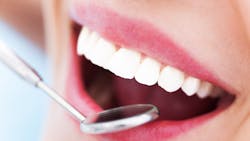We’ve all had extensive conversations with patients about brushing and flossing. Many make the attempt to brush, though the average brush time is 40-70 seconds daily (four minutes a day is recommended).1 Few floss. With these stats in mind, it’s not shocking that 64 million American adults suffer through some form of gum disease.2
What can we do to decrease this number? What we’re currently doing isn’t necessarily wrong, but we need to change our approach when it comes to the prevention and treatment of gum disease. Brushing and flossing are mechanical processes—they kill nothing, but will physically remove plaque from teeth. These two traditional steps are ineffective in helping the body fight infections of the mouth. They don’t kill microbes or reduce volatile sulfur compounds, all which have a role in gum disease. Let’s look at all three methods and how they can help fight this growing problem.
Mechanical removal
Brushing, flossing with string, flossing with water, and general interdental cleaning are all forms of mechanical removal. There’s no debate that brushing and interdental cleaning are important. These methods play a critical role in improved oral hygiene, but the actual definition of mechanical removal is “picking up germs and throwing them away, instead of killing them with chemicals or heat.”3 Brushing and flossing simply detaches some plaque from teeth and adds it to saliva mixed with toothpaste (for fresh breath, of course). It doesn’t do anything to help patients fight active infections, nor does it kill microbes that cause disease. If our ultimate goal is to reduce gum disease, brushing and flossing aren’t enough.
Systemic treatments
Once a disease has established itself in the oral cavity, it becomes more difficult to control. This is very true in cases of periodontal disease: as the problem goes untreated it becomes more complex with time. Once finally diagnosed, the active infection can be fought with an antibiotic so that periodontal therapy can begin. This is great to help treat the initial infection, but antibiotics aren’t something that can be taken long term. The patient’s body builds up resistance, potentially making future antibiotic use ineffective. We certainly don’t want this to happen. We need an additional tool to add to our patients’ toolboxes that they can safely use every day.
Therapeutic options
Therapeutic options take some of the best aspects of mechanical and systemic removal and add them into everyday care. Rinses are the main tool that fall into this category. This is where we can make a significant impact on oral health, because a rinse is easy for patients to use. In addition to killing bacteria, some rinses also reduce viruses, fungi, and volatile sulfur compounds (VSCs), and break up biofilm—all factors that contribute to a number of oral diseases. It’s important to note, however, that the criteria for choosing rinses should be rigorous, because not all rinses have all of these capabilities, nor can they all be used long term. For example, chlorhexidine, great at killing bacteria, does nothing for viruses, fungi, biofilm, or VSCs and can’t be used long term.4 In addition to its therapeutic limitations, it also creates more work due to the accumulation of stain and calculus. We want to increase patient health, not create more work.
An active ingredient to look for in rinses is activated chlorine dioxide.5 It quickly kills the same bacteria as chlorhexidine, as well as other disease-causing pathogens, but without the side effects (no staining—hooray!) and can be safely used every day long term. OraCare is a rinse that is available in dental practices that utilizes activated chlorine dioxide. This rinse also incorporates xylitol which adds to its therapeutic benefits. Bonus: it tastes great, which makes patients more likely to use it.
Gum disease is a formidable opponent, so the plan of attack needs to be consistent and include mechanical and therapeutic methods and if infection is present, systemic.
Editor's note: This article appeared in the August 2021 print edition of RDH magazine.
References
- Kaiser M. How long does the average person brush? DentistryIQ. September 30, 2014. https://www.dentistryiq.com/practice-management/patient-relationships/article/16359938/how-long-does-the-average-person-brush-check-out-this-infographic
- Eke PI, Dye BA, Wei L, et al. Prevalence of periodontitis in adults in the United States: 2009 and 2010. J Dent Res. 2012;91(10):914-920. doi:10.1177/0022034512457373
- McGrath S. Mechanical removal. Inventability. February 1, 2018. https://inventability.net/articles/tips/mechanical-removal.html
- Van Strydonck DA, Demoor P, Timmerman MF, van der Velden U, van der Weijden GA. The anti-plaque efficacy of a chlorhexidine mouthrinse used in combination with toothbrushing with dentifrice. J Clin Periodontol. 2004;31(8):691-695. doi:10.1111/j.1600-051X.2004.00546.x
- An in vitro study comparing a two-part activated chlorine dioxide oral rinse to chlorhexidine. Perio-Implant Advisory. January 15, 2015. https://www.perioimplantadvisory.com/clinical-tips/hygiene-techniques/article/16411500/an-in-vitro-study-comparing-a-twopart-activated-chlorine-dioxide-oral-rinse-to-chlorhexidine
About the Author
Kristin Goodfellow, RDH
Kristin Goodfellow, RDH, is the chief clinical officer for OraCare, a dental products company dedicated to improving the standard of care. She completed her dental hygiene degree at Allegany College of Maryland and obtained a Bachelor of Arts degree in communication studies from West Virginia University. She serves as a senior executive consultant for Cellerant, a member of the Best of Class Hygiene committee, and a liaison to seven dental practices in West Virginia. She utilizes her communication, dentistry, and leadership skills to integrate new protocols that promote optimal patient care.
Updated April 5, 2023

